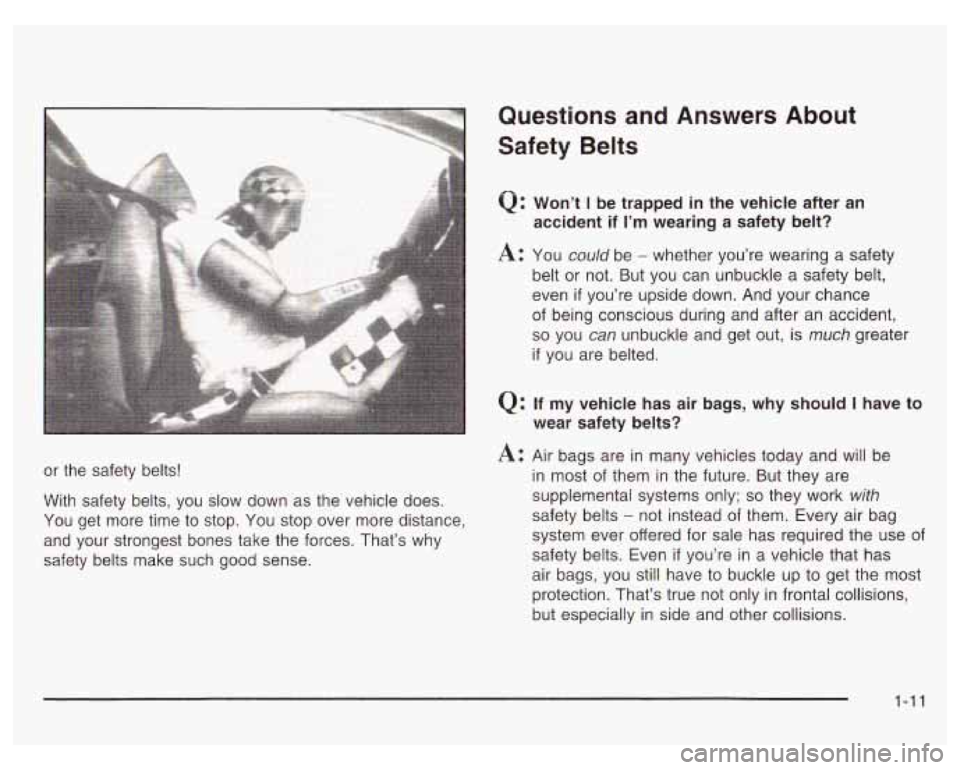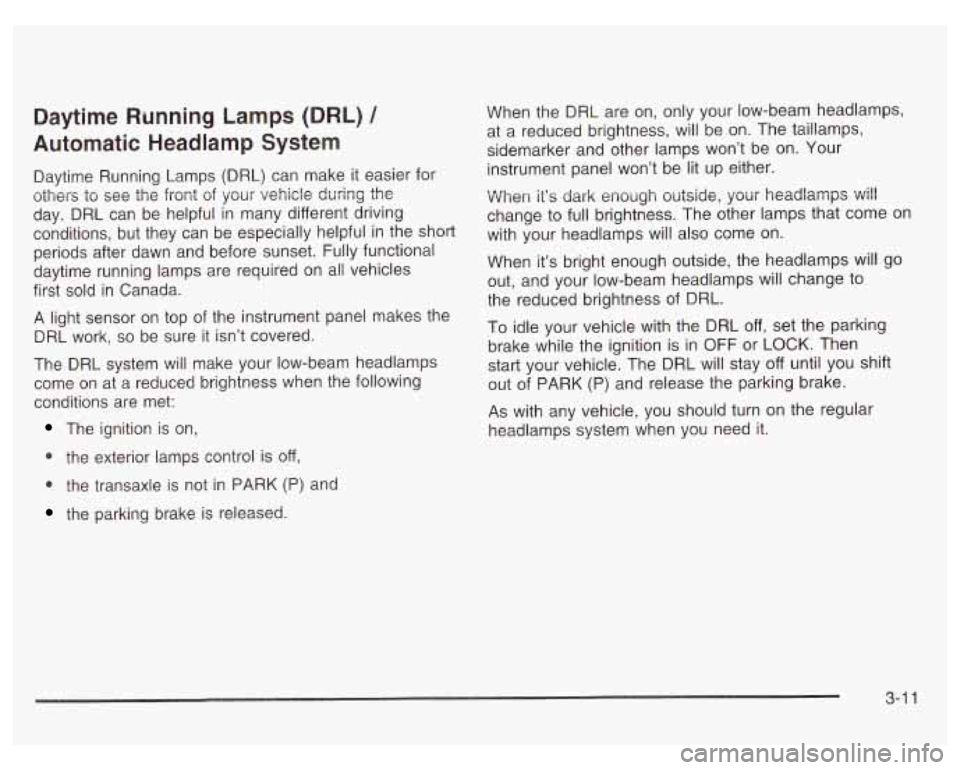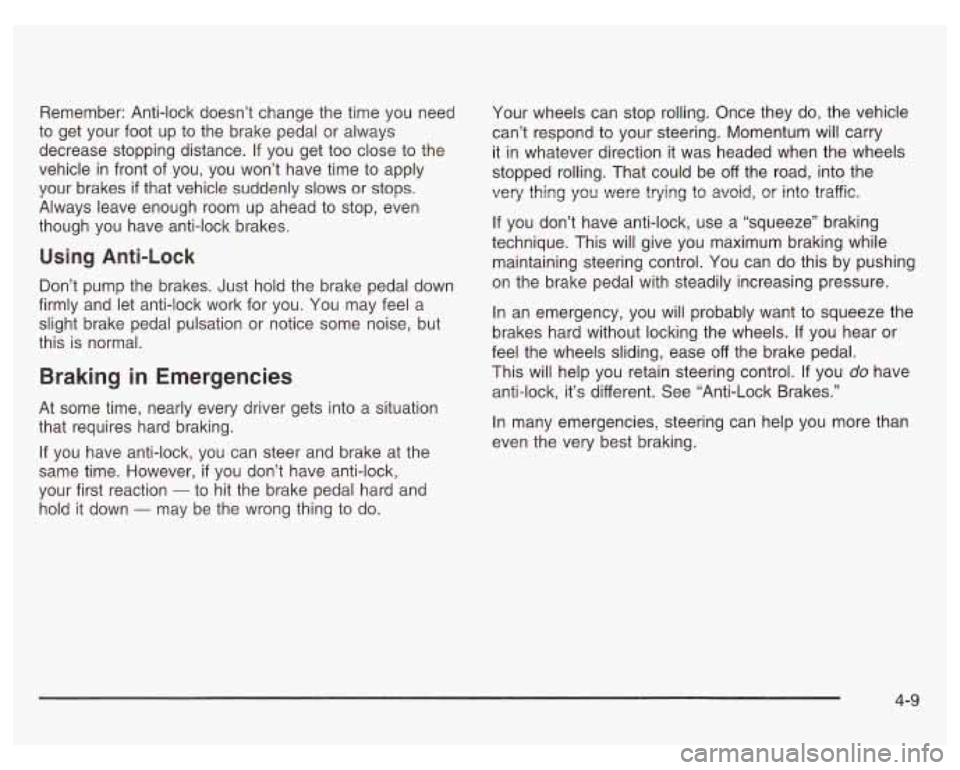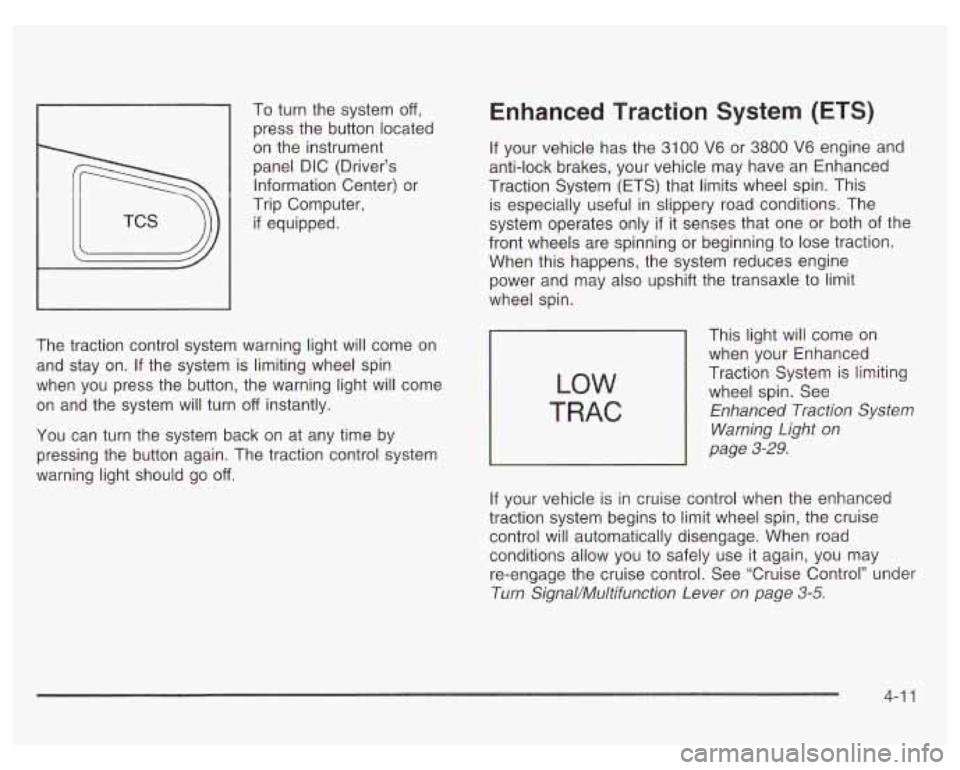ESP PONTIAC GRAND PRIX 2003 Owners Manual
[x] Cancel search | Manufacturer: PONTIAC, Model Year: 2003, Model line: GRAND PRIX, Model: PONTIAC GRAND PRIX 2003Pages: 378, PDF Size: 17.64 MB
Page 18 of 378

or the safety belts!
With safety belts, you slow down as the vehicle does.
You get more time to stop. You stop over more distance,
and your strongest bones take the forces. Thatâs why
safety belts make such good sense.
Questions and Answers About
Safety Belts
0: Wonât I be trapped in the vehicle after an
accident if
Iâm wearing a safety belt?
A: You could be - whether youâre wearing a safety
belt or not. But you can unbuckle a safety belt,
even
if youâre upside down. And your chance
of being conscious during and after an accident,
so you can unbuckle and get out, is much greater
if you are belted.
Q: If my vehicle has air bags, why should I have to
A: Air bags are in many vehicles today and will be
in most of them in the future. But they are
supplemental systems only;
so they work with
safety belts
- not instead of them. Every air bag
system ever offered for sale has required the use of
safety belts. Even
if youâre in a vehicle that has
air bags, you still have to buckle up to get the most
protection. Thatâs true not only in frontal collisions,
but especially in side and other collisions.
wear safety belts?
1-1 1
Page 75 of 378

Doors and Locks
Door Locks
There are several ways to lock and unlock your vehicle.
To lock or unlock your vehicle from the outside, use
your key or remote keyless entry transmitter.
Unlocked doors can be dangerous.
Passengers - especially children - can
easily open the doors and fall out of a
moving vehicle. When a door is locked,
the handle wonât open it. You increase the
chance of being thrown out
of the vehicle
in a crash if the doors arenât locked.
So,
wear safety belts properly and lock the
doors whenever you drive.
vehicles may be unable to get out.
A child
can be overcome by extreme heat and can
suffer permanent injuries or even death
from heat stroke. Always lock your vehicle
whenever you leave
it.
unlocked door when you slow down or
stop your vehicle. Locking your doors can
help prevent this from happening.
Young children who get into unlocked
Outsiders can easily enter through an
To unlock or lock your doors from inside the vehicle,
push the manual lever forward or rearward.
2-8
Page 80 of 378

Windows
I
Leaving children in a vehici, Jvith the ..,ndows
closed is dangerous.
A child can be overcome
by the extreme heat and can suffer permanent
injuries or even death from heat stroke. Never
leave
a child alone in a vehicle, especially with
the windows closed in warm or hot weather.
2-1 3
Page 82 of 378

Theft-Deterrent Systems
Vehicle theft is big business, especially in some cities.
Although your vehicle has a number of theft-deterrent
features,
we know that nothing we put on it can make it
impossible to steal.
Content Theft-Deterrent
Your vehicle has a theft-deterrent alarm system. A
red light located on top of the instrument panel,
toward the center of the vehicle and near the windshield,
will flash slowly when the system is armed.
While armed, the doors will not unlock with the power
door lock switch. The
alarm will souad if someone
tampers with the trunk lock, enters the vehicle without
using the remote keyless entry transmitter or key to
unlock the doors, or turns the ignition on. The horn will
sound and the headlamps will flash for up to two
minutes. The system will also cut
off the fuel supply,
preventing the vehicle from being driven.
Arming with the Power Lock Switch
Your alarm system can be programmed to arm when
you use either power lock switch to lock the
doors while
any door is open and the key is removed from the
ignition.
If you would like to arm the system with the
power lock switch, see Vehicle Personalization on
page
2-43. When programmed, the red light will flash
quickly to let you know that the system is ready to arm
with the power lock switches. When you press the
rear of a power door lock switch, the red light will stop
flashing and stay on to let you know that the system
is arming. After all the doors are closed and locked, the
red light will begin flashing at a very slow rate to let
you know the system
is armed.
2-1 5
Page 132 of 378

Daytime Running Lamps (DRL) /
Automatic Headlamp System
Daytime Running Lamps (BRL) can make it easier for
others
to see the front of y~ur vehicle during the
day. DRL can be helpful in many different driving
conditions, but they can be especially helpful in the short
periods after dawn and before sunset. Fully functional
daytime running lamps are required on all vehicles
first sold in Canada.
A light sensor on top of the instrument panel makes the
DRL work,
so be sure it isnât covered.
The DRL system will make your low-beam headlamps
come on at a reduced brightness when the following
conditions are met:
The ignition is on,
0 the exterior lamps control is off,
0 the transaxle is not in PARK (P) and
the parking brake is released. When
the DRL are on, only your low-beam headlamps,
at a reduced brightness, will be on. The taillamps,
sidemarker and other lamps wonât be on. Your
instrument panel wonât be lit up either.
When itâs dark enough outside, your headlamps
will
change to full brightness. The other lamps that come on
with your headlamps will also come on.
When itâs bright enough outside, the headlamps will go
out, and your low-beam headlamps will change to
the reduced brightness of DRL.
To idle your vehicle with the DRL off, set the parking
brake while the ignition is in OFF or LOCK. Then
start your vehicle. The DRL will stay
off until you shift
out of PARK (P) and release the parking brake.
As with any vehicle, you should turn on the regular
headlamps system when you need
it.
3-1 1
Page 178 of 378

AM FM: Press this button to select AM, FMI or FM2.
The band you select will be displayed. The frequency
will also be displayed and,
if the station is in stereo, the
stereo indicator will also be displayed.
If a cassette
tape or compact disc is playing, it will stop and the radio
will play.
SEEK A : Press the up or the down arrow to go to
the next or to the previous radio station and stay there.
If a cassette tape is playing, press the up or the down
arrow to search for the next or the previous selection on
the tape. Your tape must have at least three seconds of
silence between each selection for
SEEK to work. If a
compact disc is playing, press the up arrow to go to the
start of the next track. Press the down arrow to
go to the
start of the current track
if more than eight seconds have
played.
If less than eight seconds have played, press the
down arrow to go to the previous track.
A VOL (Volume) v: Press the up or the down arrow
to increase or to decrease volume.
PLAY: Press this button to play a cassette tape or
compact disc when listening to the radio.
MUTE: Press this button to silence the system. Press it
again, or any other radio button, to turn on the sound.
Understanding Radio Reception
AM
The range for most AM stations is greater than for FM,
especially at night. The longer range, however, can
cause stations to interfere with each other. AM can pick
up noise from things like storms and power lines. Try
reducing the treble to reduce this noise
if you ever get it.
FM stereo will give you the best sound, but
FM signals
will reach only about
10 to 40 miles (1 6 to 65 km).
Tall buildings or hills can interfere with FM signals,
causing the sound to come and go.
3-57
Page 186 of 378

But the ability to drive is affected well below a BAC of
0.10 percent. Research shows that the driving skills
of many people are impaired at a BAC approaching
0.05 percent, and that the effects are worse at night.
All drivers are impaired at BAC levels above
0.05 percent. Statistics show that the chance of being in
a collision increases sharply for drivers who have a
BAC of
0.05 percent or above. A driver with a BAC level
of
0.06 percent has doubled his or her chance of
having a collision. At a BAC level of
0.10 percent, the
chance of this driver having a collision is
12 times
greater; at a level of
0.15 percent, the chance is
25 times greater!
The body takes about an hour to rid itself of the alcohol
in one drink.
No amount of coffee or number of cold
showers will speed that up.
â1â11 be carefulâ isnât the right
answer. What
if thereâs an emergency, a need to
take sudden action, as when a child darts into the
street? A person with even a moderate BAC might
not be able to react quickly enough to avoid the
collision. Thereâs
something else about drinking and driving that
many people donât know. Medical research shows that
alcohol in a personâs system can make crash injuries
worse, especially injuries to the brain, spinal cord or
heart. This means that when anyone who has been
drinking
- driver or passenger - is in a crash, that
personâs chance of being killed or permanently disabled
is higher than
if the person had not been c lking.
C lking and the1 riving is very dangerous.
Your reflexes, perceptions, attentiveness and
judgement can be affected by even a small
amount
of alcohol. You can have a serious - or
even fatal -collision if
you drive after drinking.
Please donât drink and drive or ride with a driver
who has been drinking. Ride home in a cab; or if
youâre with a group, designate a driver who will
not drink.
4-5
Page 190 of 378

Remember: Anti-lock doesnât change the time you need
to get your foot up to the brake pedal or always
decrease stopping distance. If you get too close to the
vehicle in front of you, you wonât have time to apply
your brakes
if that vehicle suddenly slows or stops.
Always leave enough room up ahead to stop, even
though you have anti-lock brakes.
Using Anti-Lock
Donât pump the brakes. Just hold the brake pedal down
firmly and let anti-lock work for you. You may feel a
slight brake pedal pulsation or notice some noise, but
this is normal.
Braking in Emergencies
At some time, nearly every driver gets into a situation
that requires hard braking.
If you have anti-lock, you can steer and brake at the
same time. However,
if you donât have anti-lock,
your first reaction
- to hit the brake pedal hard and
hold it down
- may be the wrong thing to do. Your
wheels can stop rolling. Once they do, the vehicle
canât respond to your steering. Momentum will carry
it in whatever direction it was headed when the wheels
stopped rolling. That could be off the road, into the
very
thing you were trying to avoid, or into traffic.
If you donât have anti-lock, use a âsqueezeââ braking
technique. This will give you maximum braking while
maintaining steering control. You can do this by pushing
on the brake pedal with steadily increasing pressure.
In an emergency, you will probably want to squeeze the
brakes hard without locking the wheels. If you hear or
feel the wheels sliding, ease off the brake pedal.
This will help you retain steering control.
If you do have
anti-lock, itâs different. See âAnti-Lock Brakes.â
In many emergencies, steering can help you more than
even the very best braking.
4-9
Page 191 of 378

Traction Control System (TCS)
If your vehicle has the 3800 supercharged V6 engine it
has a traction control system that limits wheel spin.
This is especially useful in slippery road conditions. The
system operates only
if it senses that one or both of
the front wheels are spinning or beginning to lose
traction. When this happens, the system works the front
brakes and reduces engine power to limit wheel spin.
LOW
TRAC
This light will come on
when your traction control
system is limiting wheel
spin. See Traction Control
System (TCS) Warning
Light on page 3-29.
You may feel or hear the system working, but this
is normal.
If your vehicle is in cruise control when the traction
control system begins to limit wheel spin, the cruise
control will automatically disengage. When road
conditions allow you to safely use it again, you may
reengage the cruise control. See âCruise Controlâ under
Turn SignaVMultifunction Lever on page 3-5.
TCS
OFF
This light should come on
briefly when you start the
engine.
If it stays on or
comes on while you
are driving, there is a
problem with your traction
control system.
See Traction Control System (TCS) Warning Light on
page 3-29. When this warning light
is on, the system will
not limit wheel spin. Adjust your driving accordingly.
The traction control system automatically comes
on whenever you start your vehicle.
To limit wheel spin,
especially in slippery road conditions, you should
always leave the system on. But you can turn the
traction control system
off if you ever need to. You
should turn the system
off if your vehicle ever gets stuck
in sand, mud or snow and rocking the vehicle is
required. See âRocking Your Vehicle to Get It Outâ
under
If You Are Stuck: In Sand, Mud, Ice or Snow
on page
4-32.
4-1 0
Page 192 of 378

1 press the button located
To
turn the system
off,
on the instrument
panel DIC (Driverâs
Information Center) or
Trip Computer,
if equipped.
The traction control system warning light will come on
and stay on. If the system is limiting wheel spin
when you press the button, the warning light will come
on and the system will turn
off instantly.
You can turn the system back on at any time by
pressing the button again. The traction control system
warning light should go
off.
Enhanced Traction System (ETS)
If your vehicle has the 3100 V6 or 3800 V6 engine and
anti-lock brakes, your vehicle may have an Enhanced
Traction System (ETS) that limits wheel spin. This
is especially useful in slippery road conditions. The
system operates only
if it senses that one or both of the
front wheels are spinning or beginning to lose traction.
When this happens, the system reduces engine
power and may also upshift the transaxle to limit
wheel spin.
LOW
TRAC
This light will come on
when your Enhanced
Traction System is limiting
wheel spin. See
Enhanced Traction System
Warning Light
on
page 3-29.
If your vehicle is in cruise control when the enhanced
traction system begins to limit wheel spin, the cruise
control will automatically disengage. When road conditions allow you to safely use
it again, you may
re-engage the cruise control. See âCruise Controlââ under
Turn Signal/Multifunction Lever
on page 3-5.
4-1 1